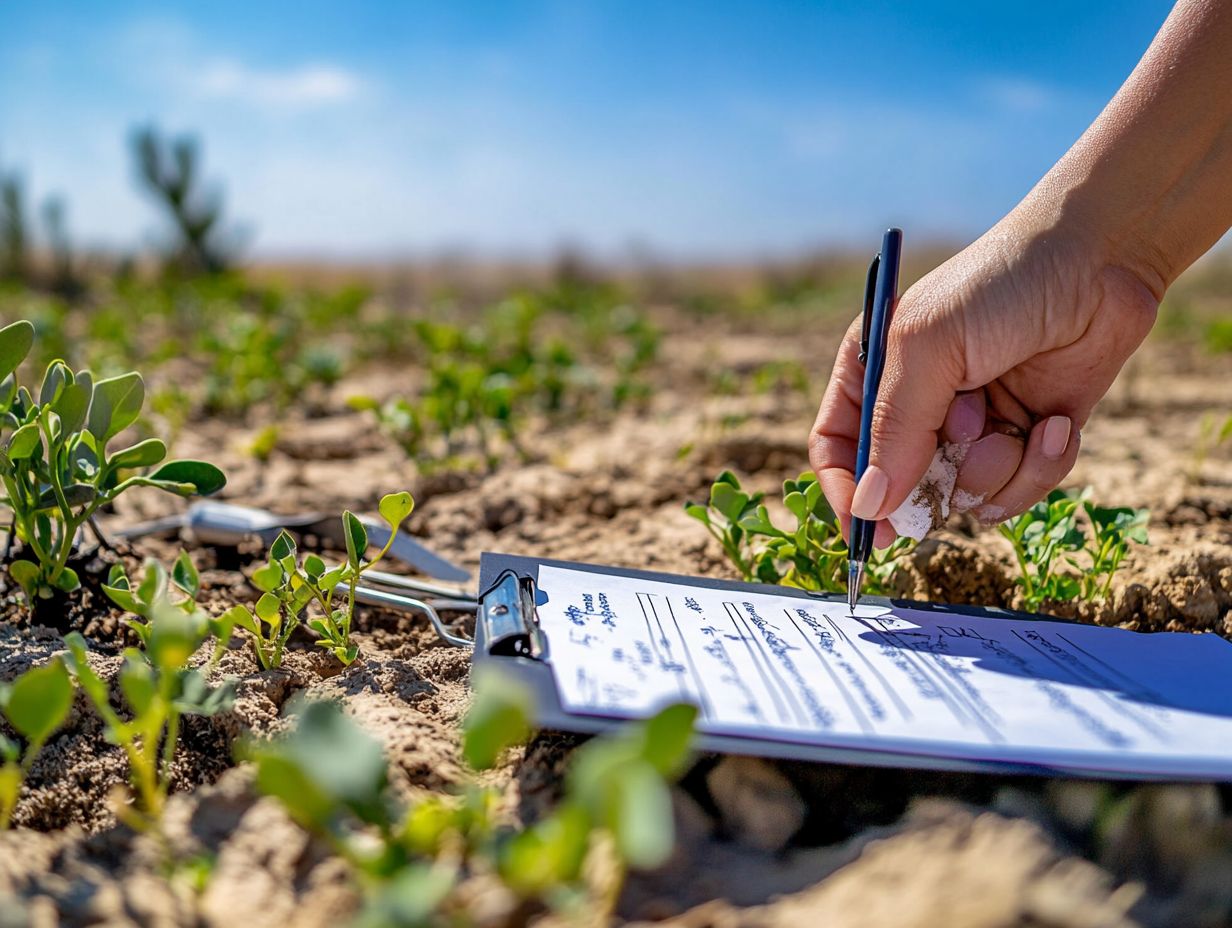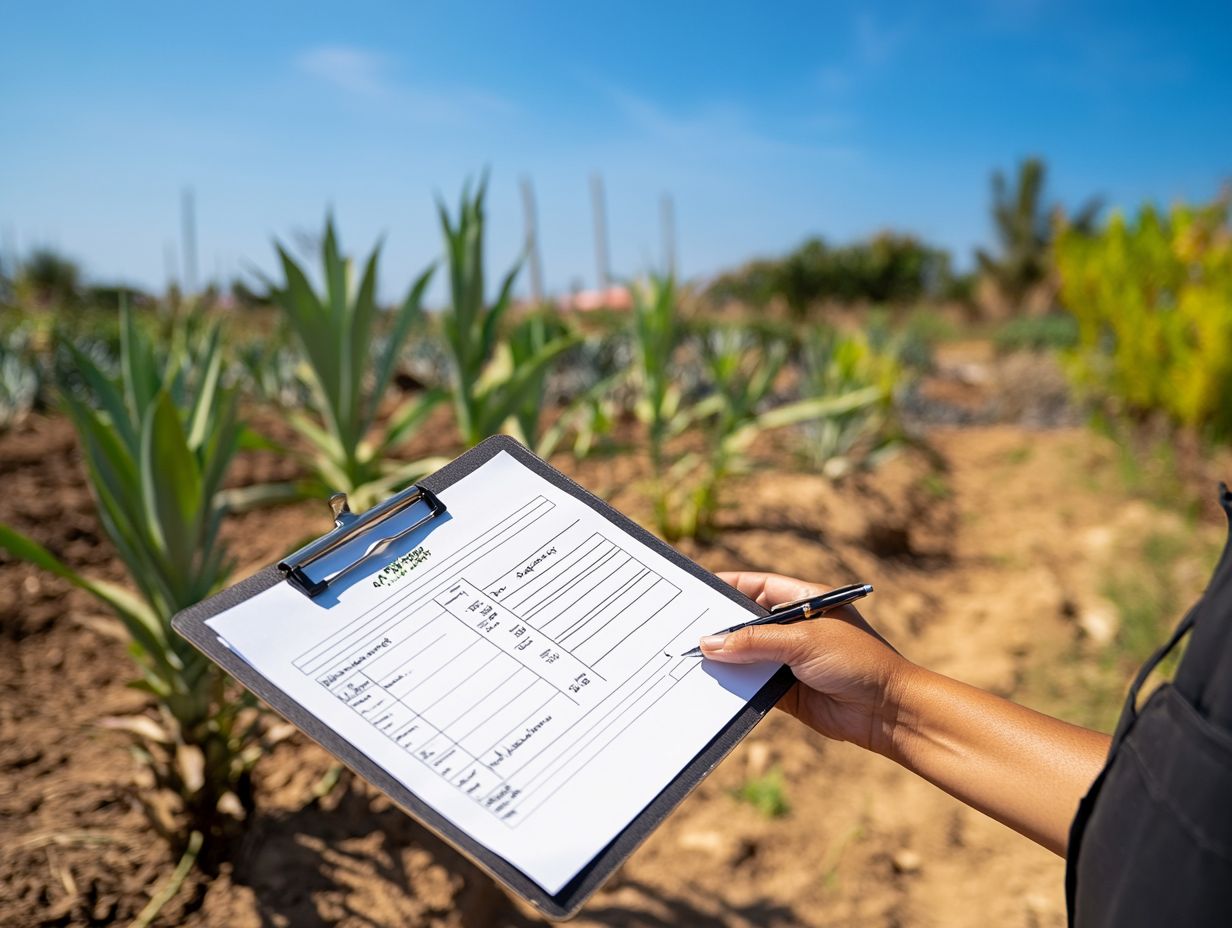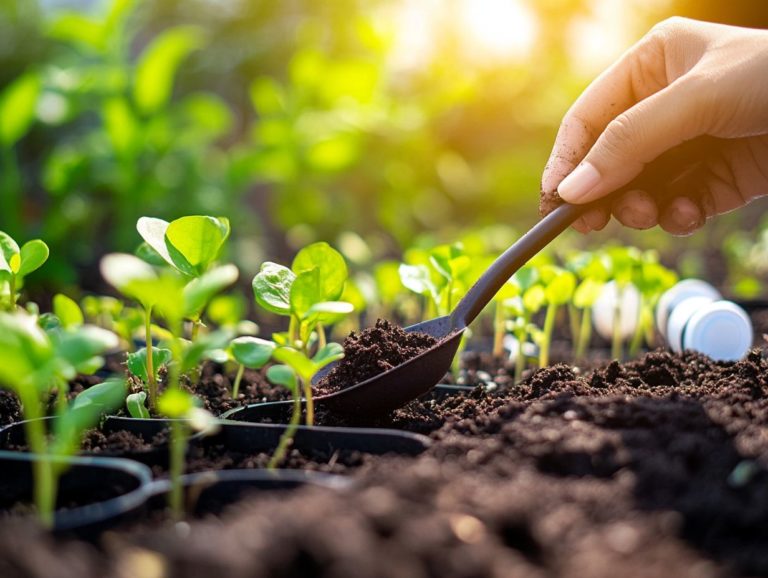Checklist for Drought Plant Maintenance
In a time when water conservation is essential, nurturing a vibrant garden during droughts is a challenge. This checklist is your key to ensuring your garden survives and thrives during dry spells.
Each section provides effective watering techniques, why mulching is important, and essential soil maintenance, equipping you with the knowledge you need to succeed.
Discover practical tips on pest control and optimal plant placement to cultivate a resilient garden.
Prepare to elevate your gardening approach and fully embrace the potential of your outdoor space!
Contents
- Key Takeaways:
- 1. Watering
- 2. Mulching
- 3. Pruning
- 4. Fertilization
- 5. Pest Control
- 6. Weed Management
- 7. Soil Maintenance
- 8. Choosing Drought-Tolerant Plants
- 9. Proper Plant Placement
- 10. Regular Inspections
- 11. Adjusting Irrigation System
- 12. Monitoring Weather Conditions
- 13. Adequate Drainage
- 14. Proper Planting Techniques
- 15. Conserving Water Usage
- Frequently Asked Questions
- What is a drought plant maintenance checklist?
- Why is a drought plant maintenance checklist important?
- What tasks should be included in a drought plant maintenance checklist?
- When should a drought plant maintenance checklist be used?
- Who should use a drought plant maintenance checklist?
- Where can I find a drought plant maintenance checklist?
Key Takeaways:

- Proper watering techniques are essential for drought plant maintenance, including using a drip or soaker hose and watering deeply but infrequently.
- Mulching can help conserve soil moisture and reduce weed growth, making it an important step in drought plant maintenance.
- Regular pruning of dead or diseased branches helps drought plants conserve energy and grow stronger, promoting their ability to withstand dry conditions.
1. Watering
Proper watering techniques are vital for cultivating a thriving garden, especially in areas grappling with drought. Incorporating deeply planned watering schedules can help establish resilient plants.
By grasping the nuances of when and how to water, you can influence soil moisture levels and effectively conserve water during the sweltering months. This ensures your plants flourish through both winter and summer.
Frequency matters tremendously; most experts recommend deep watering once or twice a week instead of shallow daily irrigation. This encourages your plants to establish deeper, more resilient root systems.
Horticulturist Ellen Zagory stresses the importance of adjusting your watering schedule to align with seasonal shifts. In hotter periods, you may need to increase your watering frequency, while the cooler months call for less supplementation.
When faced with drought conditions, careful monitoring becomes essential. Utilizing mulch can significantly help retain moisture, ensuring that each watering session penetrates the soil deeply. For more effective strategies, consider exploring seasonal care for drought-tolerant species, providing your plants with the hydration they need while minimizing waste.
2. Mulching
Mulching is an essential practice for any gardener like you. It conserves soil moisture, suppresses weeds, and elevates the aesthetic appeal of your landscaping. This is especially important during drought conditions, where moisture retention becomes crucial.
You have a variety of mulch options at your disposal, ranging from organic choices like wood chips and straw to inorganic materials such as gravel and landscape fabric. Each type contributes uniquely to the health of your soil.
Organic mulches improve soil fertility as they decompose, enriching the ground with vital nutrients. In contrast, inorganic options excel in providing long-lasting weed suppression, albeit without the nutrient enhancement.
For optimal results, apply mulch correctly by following these guidelines:
- Aim for a depth of two to four inches around your plants.
- Keep it away from the stems to prevent rot.
- Replenish it as needed.
By understanding the specific requirements of your plants and garden environment, you can significantly enhance water conservation and boost overall plant vitality.
Start your gardening journey today and make a difference for your plants!
3. Pruning
Pruning is a crucial skill for any gardener. It shapes beloved plants like hydrangeas, Japanese maples, and azaleas. Pruning at the right time whether winter or summer makes your garden shine!
Understanding the ideal timing for each type of plant is key, as it can vary significantly. Many flowering shrubs thrive with a little late winter pruning, setting the stage for vibrant blooms in spring. Some trees may benefit from summer pruning to maintain their shape and size.
To effectively prune, arm yourself with the right tools. Sharp bypass pruners, loppers, and saws are essential for making clean cuts that reduce stress on your plants.
Thoughtful pruning encourages robust growth and flowering. It transforms your garden into a visually stunning landscape that captivates those who visit.
4. Fertilization
Fertilization is essential for gardening success. It allows your plants to access important nutrients, especially during challenging conditions like drought or extreme temperatures.
Understanding the various types of fertilizers available is crucial, particularly organic options. These not only nourish your plants but also help the environment around them. Organic fertilizers, sourced from natural materials like compost, manure, and bone meal, release nutrients slowly, nurturing microbial life in your soil. When applied correctly, these fertilizers enhance soil structure and promote sustainable gardening practices.
To maximize your fertilization efforts, keep these best practices in mind:
- Test your soil to identify its nutrient needs.
- Apply fertilizers during active growth periods.
- Ensure proper watering to help nutrients penetrate the soil effectively.
This thoughtful approach supports vibrant plant growth and maintains overall soil health throughout the changing seasons.
5. Pest Control

Act quickly to protect your plants from pests! Effective pest control safeguards your plants from damage, especially during summer and winter months when pests thrive in various climates.
During these times, you may notice a surge in common nuisances like aphids, spider mites, and whiteflies. These can cause significant harm to your delicate foliage and budding blooms. To tackle these pests organically, consider using beneficial insects like ladybugs or neem oil as a natural pesticide.
Incorporating preventive measures, like crop rotation and interplanting with pest-repelling herbs such as basil or marigolds, helps create a healthier ecosystem in your garden. Maintaining soil health through composting fortifies your plants, making them less vulnerable to unwelcome visitors.
6. Weed Management
Weed management is vital for any gardener. It helps maintain soil health and promotes a thriving landscape by eliminating competition for resources, particularly during sweltering summers and chilly winters.
By understanding and implementing various techniques for weed control, you can enhance your gardening experience. Embracing organic methods, like using natural herbicides or hand-pulling, protects the environment and minimizes your exposure to chemicals.
Effective mulching strategies involve covering your soil with organic or inorganic materials. This suppresses weed growth while retaining essential moisture. Regular inspections are key for early detection, allowing you to take prompt action before weeds become a larger issue.
These strategies work together to create a harmonious ecosystem in your garden, ensuring that your plants receive the ample nutrients and support they need for optimal growth.
7. Soil Maintenance
Soil maintenance is essential for ensuring that your plants thrive in optimal conditions. By making sure the soil retains moisture and is rich in organic matter, you can effectively mitigate the impacts of drought. Avoiding common mistakes in drought plant care will also help, no matter the season.
Incorporating organic amendments like compost or well-rotted manure enriches the soil with vital nutrients and nurtures a thriving ecosystem for beneficial microorganisms. Regularly testing your soil s pH a measure of how acidic or alkaline your soil is is crucial, as it influences nutrient availability and overall soil behavior. This helps you make informed adjustments for the perfect balance.
Utilizing techniques that improve soil structure such as crop rotation, cover cropping, and minimal tillage can significantly enhance aeration and drainage. This creates an environment that promotes robust root development and boosts plant resilience against environmental stressors.
8. Choosing Drought-Tolerant Plants
Selecting drought-tolerant plants is essential for creating a sustainable landscape. Options like azaleas, evergreens, Zoysiagrass, and Bermudagrass not only add beauty to your garden but also thrive in dry conditions, making them perfect for anyone focused on conservation.
These resilient species significantly cut down on water usage. They ensure your garden flourishes even in arid climates while reducing maintenance efforts. Beyond their visual appeal, they offer vital habitats for wildlife and improve soil health by preventing erosion.
For the best plant selection, visit local nurseries that specialize in native and drought-tolerant varieties. You’ll often find a diverse array of plants tailored to your specific region. Integrating these plants into your existing landscape can be easily achieved by grouping them in beds or replacing water-loving species. This creates a seamless transition that boosts both your garden’s sustainability and its aesthetic charm.
9. Proper Plant Placement
Proper plant placement is crucial for maximizing growth potential and ensuring your plants receive the right amount of sunlight and moisture. Understanding the specific needs of each species is the cornerstone of any gardener s success in cultivating a thriving landscape.
By considering factors such as sun exposure and soil quality, you can make informed decisions about where to position each plant. For example, some varieties flourish in full sun, while others prefer the comfort of partial shade. It s essential to evaluate which areas of your garden bask in the most light throughout the day.
Assessing soil quality including pH levels and nutrient content allows you to make tailored amendments that enhance plant health. Being mindful of the moisture requirements of different species will help you avoid the pitfalls of over- or under-watering. This ultimately optimizes your garden layout for vibrant, robust growth.
10. Regular Inspections

Conducting regular inspections is essential for you as a gardener. This practice enables you to spot potential issues like pests and weeds before they escalate, thereby safeguarding the overall health of your landscape.
Establish a routine for these checks to cultivate a flourishing garden that thrives throughout the growing season. This proactive strategy keeps minor issues at bay and promotes vibrant growth!
To manage this effectively, create a checklist that includes:
- Examine foliage for any discoloration or damage.
- Look for signs of insect activity.
- Assess the surrounding soil for moisture levels.
- Check for the emergence of weeds.
Maintaining optimal conditions for your desired plants will ensure a vibrant and productive garden environment.
11. Adjusting Irrigation System
Adjusting your irrigation system is essential, especially if you re in an area facing water restrictions due to drought. It s all about delivering just the right amount of moisture without wasting any precious water.
Modern technologies like timers can help. These handy devices automate your watering schedules, ensuring your plants get the hydration they need at the most effective times.
Consider using drip irrigation systems, which allow for targeted water application directly at the roots. This dramatically cuts down on evaporation and runoff.
Adding moisture sensors to your toolkit can provide real-time insights on soil moisture levels. This helps you make timely adjustments and avoid overwatering.
By integrating these innovative solutions, you can optimize your water usage while promoting healthier plant growth, leading to a more sustainable gardening practice.
12. Monitoring Weather Conditions
Monitoring weather conditions is essential for you as a gardener. It enables you to make informed decisions about irrigation and plant care, particularly in regions susceptible to drought or extreme weather fluctuations.
By leveraging tools like weather apps and online platforms that deliver real-time forecasts, you can gain valuable insights into upcoming precipitation and temperature shifts.
These advanced technologies help you anticipate when the rain might arrive and provide a clearer understanding of humidity levels and wind patterns that impact soil moisture.
With this information at your fingertips, you can adjust your watering schedules accordingly. This ensures your plants receive the hydration they need without the risk of overwatering.
Understanding weather trends guides your choices in planting times and selecting plant species better suited to evolving climatic conditions.
13. Adequate Drainage
Adequate drainage is essential for maintaining healthy soil moisture levels and preventing water accumulation. This places it at the forefront of your sustainable landscaping efforts.
This becomes even more crucial when working with different soil types, such as clay, sandy, or loamy soils, each having unique drainage characteristics.
For example, clay soil is notorious for holding onto water, which can lead to plant stress. On the other hand, sandy soil tends to drain too quickly, requiring careful management to retain moisture effectively.
You can enhance drainage efficiency by using methods like installing French drains, utilizing raised beds, or adding organic matter to your soil.
Regularly evaluate your garden areas through straightforward techniques, such as observing water flow patterns and assessing how quickly water evaporates.
By incorporating these effective drainage strategies, you will greatly enhance the overall health of your plants, ensuring your vibrant landscapes thrive, even in challenging conditions.
14. Proper Planting Techniques
Employing proper planting techniques is essential for ensuring that your plants thrive. Understanding soil conditions and moisture requirements is crucial for anyone aiming to craft a flourishing landscape design.
To make well-informed decisions about planting, consider factors like spacing, depth, and the timing of the seasons.
Maintaining adequate spacing between plants fosters healthy growth and enhances air circulation, reducing the risk of disease. Likewise, planting at the correct depth ensures that roots receive ample support and access to vital nutrients.
Preparing the soil in advance by testing pH levels and adding organic matter can greatly improve its structure and fertility. This ultimately leads to vibrant and robust plant life.
By focusing on these best practices, you can transform your outdoor space into a lush and productive haven.
15. Conserving Water Usage

Conserving water usage is essential for gardeners, especially in regions grappling with drought. Implementing strategies to reduce waste while ensuring effective irrigation is key to sustainable gardening.
By embracing various techniques such as using drought-tolerant plants that thrive on minimal water and applying mulch to retain soil moisture you can create a stunning landscape that thrives even in tough conditions.
Utilizing smart irrigation methods like drip systems (which deliver water directly to the roots) or rainwater harvesting (collecting rainwater for irrigation) ensures that your plants receive just the right amount of hydration without excess runoff.
These practices enhance the beauty of your outdoor spaces and benefit the ecosystem, promoting biodiversity and easing the strain on local water supplies.
With these sustainable approaches, you can create both a vibrant garden and a healthier environment.
Frequently Asked Questions
What is a drought plant maintenance checklist?
A drought plant maintenance checklist is a list of tasks needed to properly care for plants during a drought. It includes actions like watering, pruning, and fertilizing to ensure plant health in drought to ensure plants’ health during water scarcity.
Why is a drought plant maintenance checklist important?
This checklist helps ensure that plants receive necessary care during a drought, preventing stress, wilting, or death. Additionally, creating a maintenance schedule for drought plants helps conserve water by promoting efficient use.
What tasks should be included in a drought plant maintenance checklist?
Tasks should include watering, mulching, pruning, and fertilizing. It’s also important to monitor for signs of drought stress and take preventative measures against excessive heat and sun exposure. For more detailed guidance, refer to maintaining a minimalist drought garden.
When should a drought plant maintenance checklist be used?
Use this checklist during water scarcity, such as droughts or water restrictions. It can also serve as a preventative measure during hot, dry weather, helping you understand how to create a drought plant care plan to keep plants healthy and hydrated.
Who should use a drought plant maintenance checklist?
Anyone caring for plants during a drought can use this checklist for homeowners, gardeners, landscapers, or farmers. It’s a useful tool for anyone wanting to ensure their plants survive water scarcity, especially with these landscape maintenance tips for drought areas.
Where can I find a drought plant maintenance checklist?
You can find drought plant maintenance checklists through apps on the Apple Store and Google Play that offer reminders and information about plant care. For more detailed resources, consider using visual aids for drought plant care. In emergencies, the Red Cross provides guidance on emergency management and resource availability. The water authority in North Carolina recommends using drought-resistant grasses like Bermudagrass and Zoysiagrass in landscaping.
Online resources, local gardening stores, and government agencies also offer checklists and resources for drought management. You can create a customized checklist based on your plants’ specific needs and the drought severity in your area. Additionally, consider using top tools for caring for drought plants and techniques like creating a garden that conserves water for efficient use.
Start today to make your garden both beautiful and sustainable!






